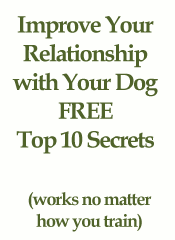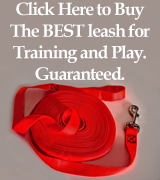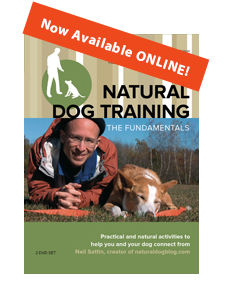Along with addressing problem behaviors in our dogs, Natural Dog Training is great for obedience. Natural Dog Training is designed to teach your dog how to do things like sit, lie down, stay - and come when called - all in an energized state. Now, why is it important to connect your dog's obedience with their emotional state? You want your dog to respond to you the times that it matters most - when company comes over, when they see a squirrel or another dog, when you encounter a deer in the woods, when you're walking down a busy street. Typically, during these high energy moments, a dog is not thinking about the situation - a dog is responding to the way that the situation makes them feel. You want your dog to know the feeling of how to be "obedient" when they're charged up by the environment - so that, for example, staying put in your driveway (off-leash) while you run across the street to help your neighbors corral one of their 8 shelties back into their garage (this actually happened, folks) is within the realm of possibility.
Fortunately, most obedience behaviors are also HUNTING behaviors. What this means is that if you can get your dog into hunting mode (which you now can do - see the learn the basics section if you need more information), then you should be able to elicit the appropriate behaviors through your body language alone. Your dog will learn what it feels like to be obedient in an energized state, which will make actual obedience "when it counts" congruous with the way the dog feels at that moment.
Think about it like this: Let's say (for our purposes) that you know how to ride a bike. In fact, you've been riding a bike for years now, so you're pretty good at it. Now, I've set up a bridge over a nearby gorge that I want you to ride across. Don't worry, the gorge is only about 100 feet deep, and only about 100 feet wide - and the bridge is really wide - about two feet (about .6 meters for the rest of the world)...with no railings! Hey, wait...why are you running in the other direction? I asked you to ride across that gorge!
Get the picture? When you teach your dog how to "sit" in the comfort of your living room, that's great! But if your dog doesn't know how to sit when there's something more emotionally compelling going on - if "sitting" just doesn't feel right in that situation - then guess what your dog will probably do when you give the "sit" command and there's a pack of golden retrievers headed your way? Anything but sit, probably.
This technique will eventually lead to training "sit", "down", and "stay". For the moment, I'm going to start with "sit" and something even more basic - "on the box!".
You're going to need a platform (or "box") that can support your dog, and that is large enough for your dog to lie down on it. I've built one for myself out of pine from the hardware store (pictured), which was pretty cheap and easy to do. Alternately, if there are benches or rocks where you train, you can use those. Just make sure that they're not too high - 6 inches off the ground is plenty, any more than 2 feet high is potentially hazardous to your dog's joints when jumping off. The point of using a box is to delimit the space where your dog will be - which will make it much easier for your dog to learn what to do as you teach them. You'll see what I mean in a moment.
Things you'll need:
- The aforementioned box.
- Your dog, preferably hungry (you can feed your dog during this training session).
- Some tasty morsels of food in a pouch.
- A long lead - attached to your dog's collar.
- A place to be.
Start out by playing with your dog, either tug or fetchtug - then switch to doing some pushing. All of this activity should take place near the box (I'm going to keep calling it "box" - but just substitute whatever you're using in its place). Your dog's motor should be revving at this point, with all attention focused on you.
Next step: using food, encourage your dog to jump up on the box. If you have to, hold some food right in front of your dog's face and lead them up onto the box. Just as your dog jumps up on the box, say "On the box!" and give an immediate food reward (all the food that's in your hand). At this point you can give some verbal praise as well (while you reload your food hand). Call your dog's name excitedly as you step away from the box, encouraging the dog to jump off the box and do some more pushing with you - at least a couple rounds of pushing. Then encourage your dog onto the box again, saying "On the Box!" at the instant they get on the box. Go through this cycle a few times.
Easy enough. Now, before we move on we need to introduce a couple food techniques into the mix. There's the "Whisk away" and the "Zing". Imagine that I'm standing there in front of you with a tasty cookie. I hold the cookie out to you, but when you reach to get it, I pull it just out of your reach with a little flick of my wrist. That's the "whisk away". As soon as your hand starts moving away from me, back into position at your side, I put the cookie right up to your mouth, so you can take it right from my hand. That's the "zing". Get it? You're going to be holding food out close to your dog's mouth and enticing your dog, but if your dog makes a move for the food you do the "whisk away". When your dog settles back you immediately "Zing!". OK.
One more food technique. I call it "feeding the position". It basically means that you just keep giving your dog food when you want your dog to stay put. You need to give the food rapidly enough that your dog doesn't move when you go for more food in your pouch. As an experiment to teach yourself this technique, encourage your dog "on the box", and then feed your dog on the box - you can think of it as "rewarding" the fact that they're on the box. What you're actually doing is keeping your dog's prey drive (which you aroused with the tug/fetchtug/pushing) engaged with the food, all the while adding energy to their position on the box.
Back to what we were doing. Use food to encourage your dog "on the box" (saying the command as they get on the box). This time, instead of calling your dog off the box, use the food to bring your dog right to the edge of the box. Keep your dog near the edge of the box for the moment, and then slowly entice your dog, as if you're trying to get them off the box, with the food. Your dog will be slightly reluctant to get off the box - it could be a hesitation, nothing more. There are two things that could happen:
- If your dog SETTLES back onto the box instead of jumping off, immediately ZING. The Zing needs to happen without hesitation. At this point, you can feed the position of your dog being on the box.
- If your dog jumps off the box...give a quick "Aye!" followed by an urgent "quick, quick, on the box!" using food to get your dog back onto the box. Once on the box, feed the position.
Another brief aside - I don't use the word "No!" anymore with my dog. Instead I use the word "Aye!", which I picked up when I was apprenticing with Kevin Behan. I think he actually uses some German word that sounds like "Aye", but "Aye!" works for me. I stopped using "No!" because I personally felt like there was too much "meaning" - for me - around the word, when in reality "No" or "Aye" or whatever you choose to say is really just an interruption of the flow of the moment, which is what stops your dogs actions. I'll probably expound upon this in a later post - suffice to say that I use "Aye!" as a replacement for the "verbal shock" of "No!"
Once your dog is back on the box, try what you were just doing again. Use the food to entice them to the edge and almost off the box. If your dog lunges for the food in your hand, Whisk Away the food quickly - not too far, just far enough to be out of your dog's reach. When you do this, notice what happens with your dog. Most likely, your dog will pull back (onto the box) - and if that happens, then Zing immediately. If your dog STILL jumps off the box, just repeat what you did before - "Aye!" followed by "quick, quick, on the box" - using the food to get your dog on the box.
Your dog has an internal efficiency mechanism at work. It won't take long for them to get the feeling that the food comes much more easily when they stay on the box - especially because jumping off the box, then on again, takes so much effort.
At some point your dog WILL become more sensitive to the edge of the box. At this point, you can play with the edge, using the Whisk Away to get them back into position, and the Zing to reward them immediately when they settle back onto the box. The "settling" could be as subtle as their head moving back away from your food hand, or as obvious as them sitting there in expectation - Zing them no matter how subtle, since the "head moving away from your food hand" will ultimately become "sitting in expectation".
Now you should be able to do a few WhiskAway/Zing combinations, feeding their position when they're on the box, followed by backing away from the box and calling their name (so that they WILL jump off the box), and some pushing on ground level. Excellent! Here are some nuances for you to play with:
- If your dog hasn't started sitting automatically yet on the box, try playing with your hand position as you tempt them at the edge of the box. Hold your food hand a little bit higher above their head, which should encourage your dog back onto the haunches and into a sit. If your dog isn't too sensitive, you could try giving a (VERY) gentle push on their lower back, just before their tail, with your non-food hand (if they jump off the box, resist, or just scoot to get away from your hand, then forget the gentle push on the rump part). You should be able to get to the point where your dog begins sitting as a response to the food being Whisked Away at the edge of the box. After all, "sitting" is what dogs naturally do when they're waiting for something to happen on the hunt. Once THAT (dog sits as food is whisked away) happens reliably, start saying "Sit" AS your dog sits. You are not commanding your dog to sit. You are simply giving a label to what your dog is already doing. Once your dog is sitting - FEED THE POSITION. Congratulations - you've taught your dog to sit while energized!
- Ultimately we are going to be working on a long down-stay. Since we haven't done the "down" yet, we can work on a simple, less intense "stay" while your dog is in the sitting position on the box. Once your dog is sitting, hold your non-food hand palm out, fingers pointed to the sky, facing your dog. You're holding your hand out as if to stay "stop right there!" Back away very slowly - not too far at first, just a few steps. Say "Ready..." and then drop your hand, call your dog's name so that they jump off the box, and do some pushing as a reward for their coming to you. You can back away slightly further next time, and you can say "Stay" (firmly) as you do.
Sitting is a relatively unstable position (compared to "down"). So don't try to go too far away. Also, if you see that your dog is going to jump off the box and come for you, immediately call their name as if you MEANT for them to come to you, and when they get to you do some pushing. Many people would instead be inclined to focus on the "stay" part with some sort of reprimand for having left position - but not you! You are going to reinforce what's right about what they just did, which was to come running at you for a push. You should make a mental note of how far away you were when that happened, or for how long you were asking them to stay in position - because you were either too far away or you made them wait too long. Next time be more gradual - don't try to go so far (or so long) so soon. Gradual, gradual, gradual.
You'll know that you've successfully mastered this lesson with your dog when your dog will go "on the box", will immediately sit when the food is whisked away, and will stay in position when you back away with your hand raised in a "stay right there" manner. The voice commands will come with time - it's the behavior and the feelings associated with the behavior that you care about. So don't obsess about what you're saying - focus on what you're doing, on reading the subtle cues of your dog's behavior, Zinging immediately when they do what you want, feeding the position when they're in the right position, and Whisking Away when they lunge for the food before you're ready to give it to them. I realize that all of this will be more clear once I've got some video to support it - so in the meantime, feel free to ask any questions. For a description of a similar exercise to round out your knowledge of how to Zing and WhiskAway, see this great article written by Lee Charles Kelley on his technique called "Trick-or-Treat". He covers a bit more ground in one article, but the general gyst is the same. We will be using the box as we move on to "down" and a more rock-solid "stay" - so "stay" tuned!





Hey Neil!
Just back from the weekend at the Rowe Conference Center which hosted Kevin's workshop. Wow, what an experience!
I am grateful for your timely article on The Box - I was thinking about it on the way home because I didn't take any notes during that session, I was just trying to absorb.
Do you have a reason for even speaking to the dog in the beginning of the exercise? I have a tendancy to over verbalize (out of nervousness? lack of focus? fear of failure? not being in the moment? all of the above?) and I'm thinking about duct-taping my mouth so I'll use the rest of myself to communicate.
Hi Angelique,
Welcome back! And great question!
No, there's no real reason to verbalize at all (other than the ultimate goal of teach verbal cues). You could exclusively use body language to do this entire exercise.
In fact, thinking more about it, that would probably be a great approach, as it would really help you see exactly how your physical position can communicate to your dog exactly what your dog needs to be doing in a given moment.
Neil, After re-reading your article a few times, reflecting on what I saw at Kevin's seminar (Kevin worked him on the box a bit), and reading Lee's article, I started working with Stevie on the box. (Side note: I've decided he's Beagle/Husky after hearing him howl and wail this weekend when left alone in his crate in the room)
Stevie's been really charged here at home and his pushing is getting stronger each session. On the box he is awesome after three sessions.
Here is what is really resonating with both of us: The whisk and the zing are pulling everything together. I mean EVERYTHING. He is learning to be energized AND still while waiting for me to come to the gate (he has been a gate bouncer since I got him), leaving the gate, etc. It is such a shift to feel how rooted he gets to the ground in the charged moments. He is ROOTED. I LOVE it!
So this dog can only eat so much food in a day, and Baker, my GSD absolutely can't eat kibble or cooked meats in any significant quantity, so I've been doing the same thing with their toys. Stevie with the bunny on a rope (AKC makes very realistic looking squeaky toys, except the bunny sounds like a duck, not a screaming bunny) and Baker with her bumper. Again, awesome results, and I had a great time reading them and orchestrating the interactions.
I'll just play with this for a few days and let things sink in.
Neil, forgot to mention that I am using leash pressure with Stevie on the box at distances up to about 12 feet. He's rock solid.